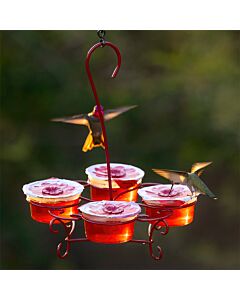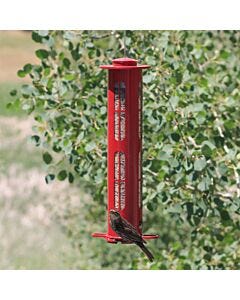Hummingbird Watching/Migration
Hummingbirds 101 »Hummingbird Watching/Hummingbird Migration
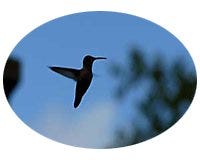
There are hundreds of hummingbird species in the world, and—unfortunately for us—most live exclusively in Central and South America. A few hummingbirds, however, are regularly seen north of Mexico, and those are the birds we’re always excited to see!
This group of hummingbirds migrates to the U.S. and Canada for the summer and then makes a dash for the equator as fall approaches. For most backyard bird enthusiasts, these feeder-and-flower visitors are a true treasure, and, with the help of hummingbird feeders, it’s easy to enjoy them, too! By properly preparing your yard for their visits, you can be assured of many hours of entertainment as these hummingbirds zip around, feeding and frolicking.
View our Interactive Hummingbird Migration Map!
About U.S. and Canadian Hummingbirds
Most of the hummingbirds that visit the U.S. will fly just past the southern U.S. border. Those casual visitors can be a rare treat for hummingbird enthusiasts. Others, including the Ruby-throated, Rufous and Anna’s, actually nest deep into the U.S. and Canada.
According to The Stokes Field Guide to the Birds of North America, there are several hummingbirds species that venture north of Mexico, some rare and some common.
Possible Hummingbird Migrants
Rare and common migratory hummingbirds to the United States and Canada:
Allen’s Hummingbird
This species maintains a tight summer range along the California coast. It’s visually similar to the Rufous Hummingbird, except its notable red gorget.
Anna’s Hummingbird
This bird is the major exception to the migration cycle – it has a year-round range that includes the West Coast of the U.S. and a part of British Columbia.
Berylline Hummingbird
The Berylline is considered a rare visitor to the southwest U.S. It is a dark green hummingbird with a light brown belly.
Black-chinned Hummingbird
The Black-chinned Hummingbird is a common sight in the western U.S. and along the borders of western Canada. Males have a distinctive band of iridescent purple around their necks.
Blue-throated Mountaingem
A large hummingbird, the Mountaingem makes spotty appearances in small parts of Arizona and Texas in the summer.
Broad-billed Hummingbird
This hummingbird will nest in southern Arizona and New Mexico, although the majority of the species sticks to Mexican territories.
Broad-tailed Hummingbird
This species is visually similar to the Ruby-throated Hummingbird, except that it’s a bit bigger and nests in the central Rocky Mountain region.
Buff-bellied Hummingbird
The best place to see the Buff-belly is where it nests -- extreme, southern Texas and into Mexico. Unlike most hummingbirds, the Buff-belly migrates north during the winter, often along the Gulf Coast.
Calliope Hummingbird
Spending its summers in the Pacific Northwest and southwestern Canada, the Calliope migrates through a large swath of the western U.S.
Costa’s Hummingbird
This hummingbird summers in southern California, Nevada, Utah and New Mexico. You can recognize this hummingbird by its pot-bellied look and full head and neck of iridescent feathers.
Green-breasted Mango
Normally a species that resides in Mexico, the Mango will sometimes journey up north, and it’s been catalogued as visiting states from Texas to North Carolina.
Green Violetear
Sometimes this hummingbird is spotted in south and central Texas, but there have been reports of them at feeders in southern Canada, too. That’s quite a journey!
Lucifer Hummingbird
With an intense purple gorget, the Lucifer is a sight to see! To catch a glimpse of it in the U.S., look for it in tiny sections of Arizona, New Mexico and Texas.
Magnificent Hummingbird
This dark-colored beauty regularly migrates into Arizona, New Mexico and Texas. Less frequently, they travel further north into Utah and Colorado.
Plain-capped Starthroat
With its violet-red throat patch, the Starthroat will occasionally venture into Arizona from Mexico.
Ruby-throated Hummingbird
Probably the most popular hummingbird in the U.S. and Canada, the Ruby-throat can be found in eastern half of the U.S. and most of the southern Canadian provinces.
Rufous Hummingbird
Engaging in a remarkable migration, the Rufous Hummingbird travels from southern Mexico to breeding grounds as far north as Alaska. The Rufous has brilliant orange-red plumage that makes it instantly recognizable.
Violet-crowned Hummingbird
Another rare visitor from Mexico, this hummingbird has a white stripe behind its eyes. It will sometimes appear in Arizona and New Mexico.
Xantus’s Hummingbird
Rather than being an “occasional” visitor to America, the Xantus’s is listed as an “accidental” visitor, meaning you’ll only see it if it got lost!
Visit our Hummingbird Library for even more information on the most common hummingbird species in the United States and Canada.
Why Do Hummingbirds Migrate?
The hummingbirds that migrate in and out of the U.S. and Canada do so to take advantage of the resources available in these northern climates. In the summer, there’s less competition for insects, the primary hummingbird food source, and flower nectar. For those hummingbirds with territorial tendencies, there’s also less competition for space, especially the further north they travel. They also face fewer predators and can find better nest sites.
But why don’t they just stay in the lush jungles of Mexico, Central America and South America? That’s certainly a good question! Although those areas are teeming with delicious bugs and flowering plants, the competition is positively fierce for those resources! In total, there are believed to be 338 species of hummingbirds, so it’s understandable that the 20 species listed above head north to relieve the pressure of competition. We’re surprised that more haven’t joined the list!
When Do Hummingbirds Migrate?
Hummingbirds migrate at different times based on their instinctual notions of when the “right time” is. That being said, northern migration from the southern reaches of their Central American ranges can begin as early as January. Arrival at their nesting sites, depending on the species, can be as late as the end of May and early June.
Once they’ve had a chance to mate, males can begin their south-bound trips as early as late July. The last south-migrating hummingbirds will cross the southern U.S. borders around Halloween.
For purposes of your backyard feeder, consider this guide on the timing of hummingbird migration.
Hummingbird Migration Zones
Extreme Southern U.S. borders, California to Florida
There’s a possibility that you’ll have hummingbirds all year long. Also, those who have Anna’s Hummingbirds may see that species throughout the year.
California to Florida, non-border
There’s a slim possibility that you could see activity all year long. Otherwise, your feeding season is probably March through late October.
Nevada to Georgia
Mid-March through early October.
Oregon to Virginia
April through late September.
Washington state to Massachusetts
Late April through early September.
British Columbia to Maine
May through late August.
Northern extremes
Mid-May through July.
This, of course, is only a rough guide. Hummingbirds may arrive or depart earlier or later depending on lingering seasonal weather and food availability.
You can also check out the perkypet.com Migration Map to monitor the various species as they approach your area from the north or south.
Ruby-throated Hummingbird Migration
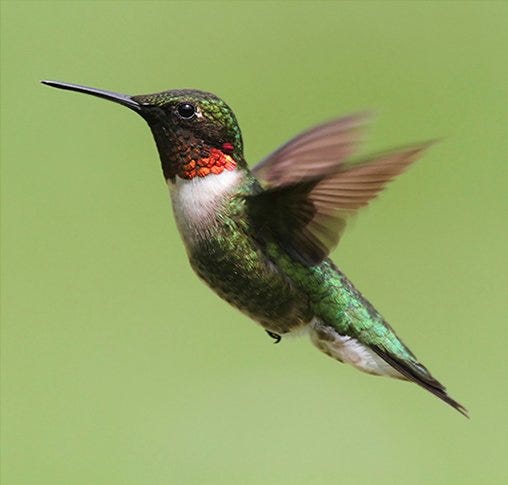
Since the Ruby-throated Hummingbird is the most common hummingbird in the U.S. and Canada, it’s migration patterns are especially noteworthy. Explore more Ruby-throated Hummingbird migration facts in our guide dedicated to them!
As a long-distance migrant, these birds will travel north from Mexico and Central America into their ranges in the Eastern U.S. and Canada. This trip often includes a lengthy, non-stop jaunt across the Gulf of Mexico that can take 20 or more hours!
Southbound migration can begin as early as August for male Ruby-throated Hummingbirds. They are usually followed by the females and juvenile Ruby-throats, who are just getting strong enough to make the difficult trek to their winter range.
Rufous Hummingbird Migration
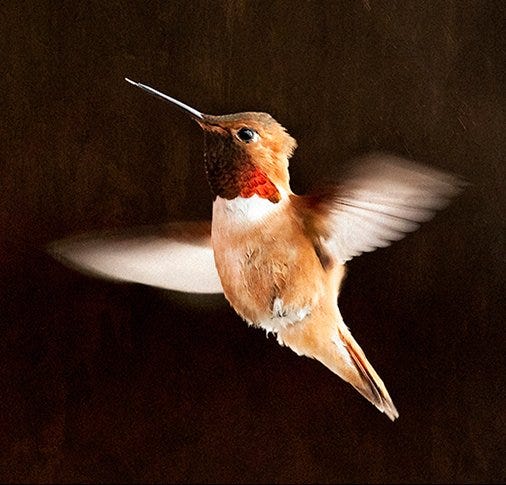
As far as hummingbird migration goes, you have to admire the Rufous Hummingbird. This hummingbird goes to the extreme when it migrates!
With a winter range in southern Mexico, some Rufous Hummingbirds will fly all the way to Alaska to breed. Based on the Rufous’ body length, this 3,900-mile journey is one of the longest migration trips of any bird.
Another interesting aspect about the migration of Rufous Hummingbirds is the circular route they use. When they travel north, these hummingbirds fly along the West Coast. Their southern migration, however, tends to trace the Rocky Mountains. Most birds follow a direct route in both directions, only altering the route to find food and water, or to avoid big obstacles like mountain ranges.
Black-chinned Hummingbird Migration

With a summer range that includes most of the states immediately surrounding the Rocky Mountains, the Black-chinned Hummingbird can be a fairly common feeder visitor. What’s interesting is that its summer range is positively huge compared to its winter range. In Mexico, the species sticks to a slim section in the southwest coast during the winter.
These birds are considered to be one of the most adaptable of all the North American hummingbird species. They’re often seen in urban settings and areas recovering from wildfires. Their adaptability is also demonstrated in migration tactics – even if food is scarce elsewhere, they’ll rarely stay at one feeder for more than one day. To them, setting back out on their journey is everything!
Hummingbird Migration Routes
Like all migrating birds, hummingbirds tend to follow the flyways that guide birds to their winter and summer ranges. In North America, there are four flyways that cover the continent – the Pacific, the Central, the Mississippi and the Atlantic.
Ruby-throated Hummingbirds will follow either the Mississippi or the Atlantic, both of which can take them to the upper reaches of their northern range. On the journey south, these flyways funnel them into Central America.
Most of the other hummingbirds that migrate in and out of the U.S. and Canada follow the Pacific or Central Flyways. Of course, some don’t follow these flyways very far! Those with summer ranges that end in Arizona, New Mexico and Texas tend to migrate short distances.
Rufous Hummingbirds split their use of flyways. Heading north, these hummingbirds use the Pacific Flyway. On their journey south, they use the Central.
Migration Map
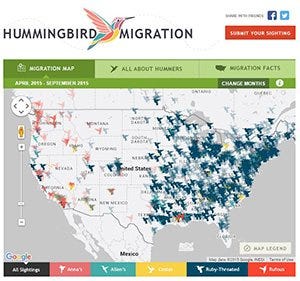
The Hummingbird Migration Map is a valuable tool for the hummingbird enthusiasts of North America. Individual bird lovers like you are asked to log their hummingbird sightings throughout the spring, summer and fall.
Adding these sightings helps your neighbors to the north and south prepare for coming surges in activity as hummingbirds move along their migration routes. That means they can have feeders ready for new visitors!
To log a sighting, click the red “Submit Your Sighting” button and fill out the information as best as you can. If you happened to take a picture of your visitor, you can also submit that!
To gauge hummingbird activity in your area, you can view the map and zoom in as necessary. To narrow your search, you can change the month to the current month or view past migration patterns. The colored buttons along the bottom of the map allow you to see the sightings of specific species.
Hummingbird Migration
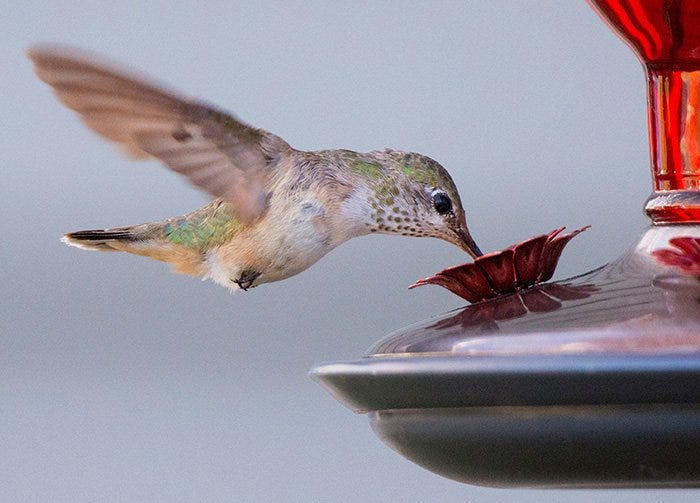
The hummingbird species that visit the U.S. and Canada during their migration cycles are truly amazing. To keep them coming back, remember to clean your hummingbird feeders regularly, keep the nectar inside fresh and plant the flowers they love. By taking care of these amazing creatures, they’ll reward us with their charming habits and amazing iridescent plumage.
From the beauty of the Ruby-throated Hummingbird to the admirable endurance of the Rufous Hummingbird, these little birds are definitely a treat to see in our backyards!
Perkypet.com is the top destination to find quality Wild Bird Feeders and Accessories. Perky-Pet® and K-Feeders wild bird products are trusted brands to bird lovers everywhere. Interact with nature, relax and build memories that last a lifetime by conveniently ordering from perkypet.com. Happy Bird Feeding!







